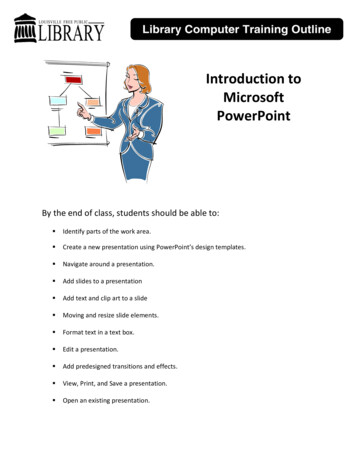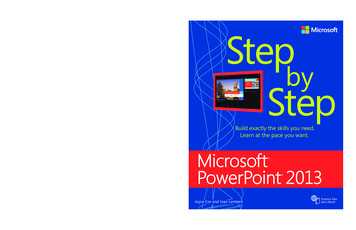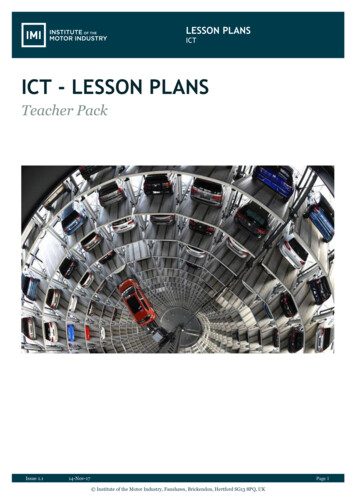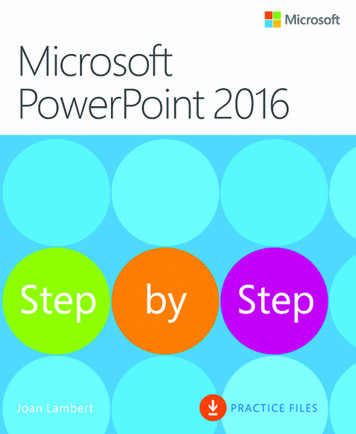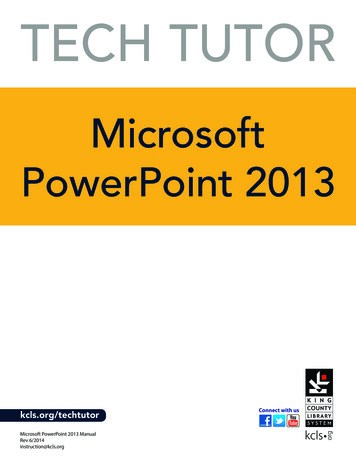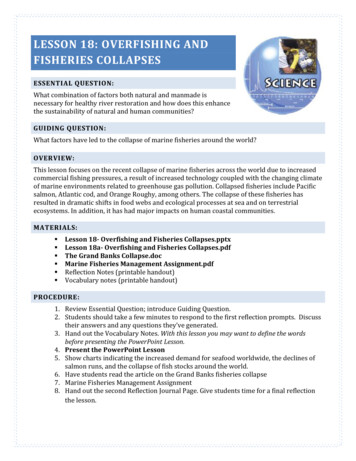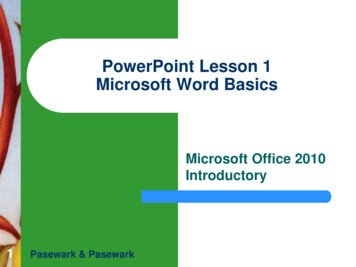
Transcription
PowerPoint Lesson 1Microsoft Word BasicsMicrosoft Office 2010Introductory1Pasewark & Pasewark
ObjectivesPowerPoint Lesson 1 2 Start PowerPoint, and understand theelements of the PowerPoint window.Open an existing presentation, and save itwith a new name.Navigate a presentation and change views.Use the Slides and Outline tabs and the Slideand Notes panes.Pasewark & PasewarkMicrosoft Office 2010 Introductory
Objectives (continued)PowerPoint Lesson 1 3 Change the layout on a slide.Delete a slide.Print a presentation.Exit PowerPoint.Pasewark & PasewarkMicrosoft Office 2010 Introductory
VocabularyPowerPoint Lesson 1 4animationbroadcastinghandoutslayoutLive PreviewNormal viewNotes Page viewNotes paneOutline tabPasewark & Pasewark PowerPoint presentationReading viewSlide paneSlide Show viewSlide Sorter viewSlides tabthumbnailstransitionMicrosoft Office 2010 Introductory
Introduction to PowerPointPowerPoint Lesson 1 PowerPoint is a program used to createprofessional presentations.Presentations can dio–––––Pasewark & Pasewarkvideoflash animation filesanimated clip artmovie clipslinks to Web sitesMicrosoft Office 2010 Introductory
Starting PowerPointPowerPoint Lesson 1 6 Click the Start button on the taskbar.Click All Programs on the Start menu.Click the Microsoft Office folder.Click Microsoft Office PowerPoint 2010.Pasewark & PasewarkMicrosoft Office 2010 Introductory
PowerPoint Lesson 1Reviewing the PowerPoint Window7 The PowerPoint window shares severalcommon elements and tools with other Officeprograms.Normal view allows you to add and deleteslides, and add text and elements to slides.The Home tab is the default tab on theRibbon and includes many of the commandsyou will use most often.Pasewark & PasewarkMicrosoft Office 2010 Introductory
Reviewing the PowerPoint Window(continued)PowerPoint window in Normal viewPowerPoint Lesson 1 8Pasewark & PasewarkMicrosoft Office 2010 Introductory
Opening an Existing Presentationand Viewing a Slide ShowPowerPoint Lesson 1 9 To open a recently viewed presentation, youcan choose the presentation from the RecentPresentations list in Backstage view.To view the presentation as a slide show,click the Slide Show button on the status bar.Pasewark & PasewarkMicrosoft Office 2010 Introductory
Opening an Existing Presentation andViewing a Slide Show (continued)PowerPoint Lesson 1 10 A slide show is a series of slides.Transition refers to the way each new slideappears on the screen.An animation is an effect you can apply totext, objects, graphics, or pictures to makethose objects move during a slide showPasewark & PasewarkMicrosoft Office 2010 Introductory
Opening an Existing Presentation andViewing a Slide Show (continued)Title slide for Tornadoes presentationPowerPoint Lesson 1 11Pasewark & PasewarkMicrosoft Office 2010 Introductory
Saving a PresentationPowerPoint Lesson 1 12 To save a new presentation the first time,you use the Save As command.The next time you want to save changes toyour presentation, click the Save button onthe Quick Access Toolbar or press Ctrl S.Pasewark & PasewarkMicrosoft Office 2010 Introductory
Saving a Presentation (continued)Save As dialog boxPowerPoint Lesson 1 13Pasewark & PasewarkMicrosoft Office 2010 Introductory
Changing ViewsPowerPoint Lesson 1 14You can view a presentation in five ways:–––––Normal view: Where you do most of your work.Reading view: Slide almost fills screen.Slide Sorter view: Displays thumbnails of your slidesso you can easily rearrange them.Slide Show view: Your presentation is shown fullscreen as if being seen by an audience.Notes Page view: Displays slides on top of the pageand speaker notes below.Pasewark & PasewarkMicrosoft Office 2010 Introductory
Changing Views (continued)PowerPoint Lesson 1 15To change views:–Go to the Presentation Views group on the Viewtab.–View shortcuts on the status bar.Pasewark & PasewarkMicrosoft Office 2010 Introductory
Changing Views (continued)PowerPoint Lesson 1 16In Normal View you can have up to four panes:–––––Slides tab and Outline tab: Slides tab showsthumbnails of your slides and Outline tab shows textin an outline format.Slide pane: Displays one slide at a time, and offersan opportunity to edit text.Notes pane: Where you add speaker notes.Task pane: Opens up on the right for some taskssuch as inserting clip art.Pasewark & PasewarkMicrosoft Office 2010 Introductory
Changing Views (continued)PowerPoint Lesson 1 17 The Ribbon contains commands for the tasksyou will use when creating presentations.The Live Preview feature lets you preview atheme before applying it in your presentation.The Slide pane is the workbench forPowerPoint presentations, displaying slides in alarge work area.Pasewark & PasewarkMicrosoft Office 2010 Introductory
Inserting a New Slide with a NewSlide LayoutPowerPoint Lesson 1 18You can choose a layout when you insert a newslide or change the layout of an existing slide.–––Slide layout: How objects are placed on a slide.Objects: Text, images, illustrations, tables, media,and charts.Default layout: Includes placeholders for titles, text,and content.Pasewark & PasewarkMicrosoft Office 2010 Introductory
Inserting a New Slide with a NewSlide Layout (continued)Default layoutsPowerPoint Lesson 1 19Pasewark & PasewarkMicrosoft Office 2010 Introductory
Notes Page ViewPowerPoint Lesson 1 20Notes Page view displays your slides on thetop of the page, with speaker appearing inthe Notes pane on the bottom of the page.––You can use the notes to help guide you duringthe presentation.Notes are also helpful if you print a handout foryour audience.Pasewark & PasewarkMicrosoft Office 2010 Introductory
Using Slide Sorter ViewPowerPoint Lesson 1 21 Slide Sorter view displays thumbnails of theslides so that you can move and arrange slideseasily by clicking and dragging.Slide Sorter view gives you an overview of theentire presentation.Pasewark & PasewarkMicrosoft Office 2010 Introductory
Using Slide Sorter View (continued)Slide sorter viewPowerPoint Lesson 1 22Pasewark & PasewarkMicrosoft Office 2010 Introductory
Using Slide Show ViewPowerPoint Lesson 1 23 In Slide Show view, you run yourpresentation on your computer as if it were aslide projector.Each slide fills the screen and anyanimations, sounds, and videos included inthe presentation play.Pasewark & PasewarkMicrosoft Office 2010 Introductory
Using Slide Show view (continued)PowerPoint Lesson 1 Move the mouse to the lower-left corner of thescreen as the slide show runs to access Slide Showtoolbar.Commonly-used commands in Slide Show view24Pasewark & PasewarkMicrosoft Office 2010 Introductory
Using Reading ViewPowerPoint Lesson 1 25In Reading view, the slide does not quite fill the screenand displays navigation buttons.Slide in Reading viewPasewark & PasewarkMicrosoft Office 2010 Introductory
Deleting SlidesPowerPoint Lesson 1 26 In Normal view, display the slide you wantto delete, press Delete on the keyboard.You can also delete a slide, by right-clickingthe slide, then click Delete Slide on theshortcut menu.If you accidentally delete a slide, click theUndo Delete Slide button on the QuickAccess Toolbar to restore the slide.Pasewark & PasewarkMicrosoft Office 2010 Introductory
Printing a PresentationPowerPoint Lesson 1 27PowerPoint offers several print options,including:–––Print all slides or a text outline of yourpresentation.Print handouts with 2 to 9 slides per page.Print only the current slide, or any combinationof slides in your presentation.Pasewark & PasewarkMicrosoft Office 2010 Introductory
Printing a Presentation (continued)Print optionsPowerPoint Lesson 1 28Pasewark & PasewarkMicrosoft Office 2010 Introductory
Closing a Presentation and ExitingPowerPointPowerPoint Lesson 1 29 Click the File tabIn the navigation bar, click Exit, or click thepresentation window Close button.Pasewark & PasewarkMicrosoft Office 2010 Introductory
PowerPoint Lesson 1Summary30In this lesson, you learned: PowerPoint is an Office application that can help youcreate a professional presentation. When you startPowerPoint, you have the choice of opening an existingpresentation or creating a new one. You can view your presentation in five different ways:Normal view, Slide Sorter view, Slide Show view, Readingview, and Notes Page view. Each view has its ownadvantages. You can insert slides, add text and objects to slides, anddelete slides as you work to create the presentation.Pasewark & PasewarkMicrosoft Office 2010 Introductory
Summary (continued)PowerPoint Lesson 1 31To view the presentation with animations and transitions,you use Slide Show or Reading view. A slide show canadvance automatically or by clicking or pressing specifickeys on the keyboard.You can print your presentation as slides using the Slidesoption, with notes using the Notes Pages option, or as anoutline using the Outline View option. You can also chooseto print handouts with two, three, four, six, or nine slides perpage.To exit PowerPoint, click the File tab on the Ribbon, andthen in the navigation bar, click Exit.Pasewark & PasewarkMicrosoft Office 2010 Introductory
Lesson 1 14 Pasewark & Pasewark Microsoft Office 2010 Introductory Changing Views You can view a presentation in five ways: -Normal view: Where you do most of your work. -Reading view: Slide almost fills screen. -Slide Sorter view: Displays thumbnails of your slides so you can easily rearrange them. -Slide Show view: Your presentation is shown full

